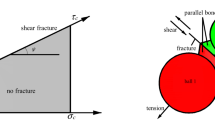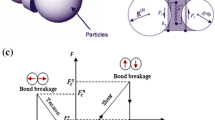Abstract
Using Particle Flow Code, a discrete element model is presented in this paper that allows direct modeling of stick-slip behavior in pre-existing weak planes such as joints, beddings, and faults. The model is used to simulate a biaxial sliding experiment from literature on a saw-cut specimen of Sierra granite with a single fault. The fault is represented by the smooth-joint contact model. Also, an algorithm is developed to record the stick-slip induced microseismic events along the fault. Once the results compared well with laboratory data, a parametric study was conducted to investigate the evolution of the model’s behavior due to varying factors such as resolution of the model, particle elasticity, fault coefficient of friction, fault stiffness, and normal stress. The results show a decrease in shear strength of the fault in the models with smaller particles, smaller coefficient of friction of the fault, harder fault surroundings, softer faults, and smaller normal stress on the fault. Also, a higher rate of displacement was observed for conditions resulting in smaller shear strength. An increase in b-values was observed by increasing the resolution or decreasing the normal stress on the fault, while b-values were not sensitive to changes in elasticity of the fault or its surrounding region. A larger number of recorded events were observed for the models with finer particles, smaller coefficient of friction of the fault, harder fault surroundings, harder fault, and smaller normal stress on the fault. The results suggest that it is possible for the two ends of a fault to be still while there are patches along the fault undergoing stick-slips. Such local stick-slips seem to provide a softer surrounding for their neighbor patches facilitating their subsequent stick-slips.

















Similar content being viewed by others
References
Brace, W. F., and Byerlee, J. (1966), Stick-slip as a mechanism for earthquakes. Science, 153(3739), 990–992.
Brace, W. F., and Byerlee, J. (1970), California earthquakes: why only shallow focus? Science (New York, N.Y.), 168(3939), 1573–1575. doi:10.1126/science.168.3939.1573.
Brune, J. N., Brown, S., and Johnson, P. A. (1993), Rupture mechanism and interface separation in foam rubber models of earthquakes: a possible solution to the heat flow paradox and the paradox of large overthrusts. Tectonophysics, 218(1–3), 59–67. doi:10.1016/0040-1951(93)90259-M.
Byerlee, J. (1978), Friction of rocks. Pure and Applied Geophysics PAGEOPH, 116(4–5), 615–626. doi:10.1007/BF00876528.
Byerlee, J., and Brace, W. F. (1968), Stick slip, stable sliding, and earthquakes—effect of rock type, pressure, strain rate, and stiffness. Journal of Geophysical Research, 73(18), 6031–6037.
Dalguer, L. A., and Day, S. M. (2006), Comparison of fault representation methods in finite difference simulations of dynamic rupture. Bulletin of the Seismological Society of America, 96(5), 1764–1778.
Damjanac, B., Gil, I., Pierce, M., Sanchez, M., Van As, A., and McLennan, J. (2010), A New Approach to Hydraulic Fracturing Modeling In Naturally Fractured Reservoirs. 44th U.S. Rock Mechanics Symposium and 5th U.S.-Canada Rock Mechanics Symposium. Retrieved from https://www.onepetro.org/conference-paper/ARMA-10-400.
Day, S. M., Dalguer, L. A., Lapusta, N., and Liu, Y. (2005), Comparison of finite difference and boundary integral solutions to three-dimensional spontaneous rupture. Journal of Geophysical Research: Solid Earth (1978–2012), 110(B12).
Dieterich, J. H. (1979), Modeling of rock friction: 1. Experimental results and constitutive equations. Journal of Geophysical Research, 84(B5), 2161. doi:10.1029/JB084iB05p02161.
Dieterich, J. H. (1981), Potential for geophysical experiments in large scale tests. Geophysical Research Letters, 8(7), 653–656. doi:10.1029/GL008i007p00653.
Fairhurst, C. (2013), Fractures and Fracturing: Hydraulic Fracturing in Jointed Rock. ISRM International Conference for Effective and Sustainable Hydraulic Fracturing. Retrieved from https://www.onepetro.org/conference-paper/ISRM-ICHF-2013-012.
Finch, E., Hardy, S., and Gawthorpe, R. (2003), Discrete element modelling of contractional fault-propagation folding above rigid basement fault blocks. Journal of Structural Geology, 25(4), 515–528. doi:10.1016/S0191-8141(02)00053-6.
Galis, M., Moczo, P., and Kristek, J. (2008), A 3-D hybrid finite-difference—finite-element viscoelastic modelling of seismic wave motion. Geophysical Journal International, 175(1), 153–184.
Hazzard, J. (1998), Numerical modelling of acoustic emissions and dynamic rock behaviour. [electronic resource]. University of Keele.
Hazzard, J., Collins, D. S., Pettitt, W. S., and Young, R. P. (2002), Simulation of unstable fault slip in granite using a bonded-particle model. In The Mechanism of Induced Seismicity (pp. 221–245). Springer.
Hazzard, J., and Pettitt, W. S. (2013), Advances in Numerical Modeling of Microseismicity. In 47th US Rock Mechanics/Geomechanics Symposium. American Rock Mechanics Association.
Hazzard, J., and Young, R. P. (2000), Simulating acoustic emissions in bonded-particle models of rock. International Journal of Rock Mechanics and Mining Sciences, 37(5), 867–872. Retrieved from http://cat.inist.fr/?aModele=afficheN&cpsidt=1419981.
Hazzard, J., and Young, R. P. (2002), Moment tensors and micromechanical models. Tectonophysics, 356(1), 181–197.
Hazzard, J., and Young, R. P. (2004), Dynamic modelling of induced seismicity. International Journal of Rock Mechanics and Mining Sciences, 41(8), 1365–1376.
Itasca, C. G. (1999). PFC 3D-User manual. Itasca Consulting Group, Minneapolis.
Jansen, F. (2006), Numerical Simulation of Stick-slip Processes with Application to Seismology and Rock Glacier Dynamics.
Julian, B. R., Miller, A. D., and Foulger, G. R. (1998), Non-double-couple earthquakes 1. Theory. Reviews of Geophysics, 36(4), 525. doi:10.1029/98RG00716.
Kristiansen, T. G., Barkved, O., and Pattillo, P. D. (2000), Use of passive seismic monitoring in well and casing design in the compacting and subsiding Valhall field, North Sea. In EUROPEC: European petroleum conference (pp. 231–241).
Mas Ivars, D. (2008), Bonded-Particle Model for the Deformation, Yield and Failure of Jointed Rock Masses. In PhD Thesis. Stockholm, Sweden.
Mas Ivars, D., Potyondy, D. O., Pierce, M., and Cundall, P. A. (2008), The smooth-joint contact model. Proceedings of WCCM8-ECCOMAS.
McGarr, A. (1994), Some comparisons between mining-induced and laboratory earthquakes. Pure and Applied Geophysics PAGEOPH, 142(3–4), 467–489. doi:10.1007/BF00876051.
McLaskey, G. C., and Kilgore, B. D. (2013), Foreshocks during the nucleation of stick-slip instability. Journal of Geophysical Research: Solid Earth, 118(6), 2982–2997. doi:10.1002/jgrb.50232.
McLaskey, G. C., Kilgore, B. D., Lockner, D. A., and Beeler, N. M. (2014), Laboratory Generated M -6 Earthquakes. Pure and Applied Geophysics. doi:10.1007/s00024-013-0772-9.
McLaskey, G. C., Thomas, A. M., Glaser, S. D., and Nadeau, R. M. (2012), Fault healing promotes high-frequency earthquakes in laboratory experiments and on natural faults. Nature, 491(7422), 101–104. Retrieved from http://dx.doi.org/10.1038/nature11512.
Mora, P., and Place, D. (1994), Simulation of the frictional stick-slip instability. Pure and Applied Geophysics, 143(1–3), 61–87.
Morgan, J. K. (2004), Particle Dynamics Simulations of Rate- and State-dependent Frictional Sliding of Granular Fault Gouge. Pure and Applied Geophysics, 161(9–10). doi:10.1007/s00024-004-2537-y.
Nielsen, S., Carlson, J. M., and Olsen, K. B. (2000), Influence of friction and fault geometry on earthquake rupture. Journal of Geophysical Research, 105(B3), 6069. doi:10.1029/1999JB900350.
Nielsen, S., Knopoff, L., and Tarantola, A. (1995), Model of earthquake recurrence: role of elastic wave radiation, relaxation of friction, and inhomogeneity. Journal of Geophysical Research: Solid Earth (1978–2012), 100(B7), 12423–12430.
Ohnaka, M. (1973), Experimental studies of stick-slip and their application to the earthquake source mechanism. Journal of Physics of the Earth, 21(3), 285–303.
Peng, Z., and Gomberg, J. (2010), An integrated perspective of the continuum between earthquakes and slow-slip phenomena. Nature Geoscience, 3(9), 599–607. doi:10.1038/ngeo940.
Persson, B. N. J., and Tosatti, E. (1999), Theory of friction: elastic coherence length and earthquake dynamics. Solid State Communications, 109(12), 739–744.
Place, D., Lombard, F., Mora, P., and Abe, S. (2002), Simulation of the micro-physics of rocks using LSMearth. In Earthquake Processes: Physical Modelling, Numerical Simulation and Data Analysis Part I (pp. 1911–1932). Springer.
Potyondy, D. O., and Cundall, P. A. (2004), A bonded-particle model for rock. International Journal of Rock Mechanics and Mining Sciences, 41(8), 1329–1364. doi:10.1016/j.ijrmms.2004.09.011.
Rabinowicz, E. (1951), The Nature of the Static and Kinetic Coefficients of Friction. Journal of Applied Physics, 22(11), 1373. doi:10.1063/1.1699869.
Rabinowicz, E. (1958), The Intrinsic Variables affecting the Stick-Slip Process. Proceedings of the Physical Society, 71(4), 668–675. doi:10.1088/0370-1328/71/4/316.
Roux, P.-F., Marsan, D., Métaxian, J.-P., O’Brien, G., and Moreau, L. (2008), Microseismic activity within a serac zone in an alpine glacier (Glacier d’Argentìere, Mont Blanc, France). Journal of Glaciology, 54(184), 157–168. doi:10.3189/002214308784409053.
Scholz, C. H. (2002), The mechanics of earthquakes and faulting. Cambridge university press.
Xing, H. L., Mora, P., and Makinouchi, A. (2004), Finite element analysis of fault bend influence on stick-slip instability along an intra-plate fault. In Computational Earthquake Science Part I (pp. 2091–2102). Springer.
Young, R. P., Collins, D. S., Hazzard, J., Pettitt, W., and Baker, C. (2001), Use of acoustic emission and velocity methods for validation of micromechanical models at the URL (p. 153). Toronto, Ont.: Ontario Power Generation, Nuclear Waste Management Division.
Young, R. P., and Dedecker, F. (2005), Seismic Validation of 3-D Thermo-Mechanical Models for the Prediction of the Rock Damage around Radioactive Waste Packages in Geological Repositories-SAFETI. Final Report, European Commission Nuclear Science and Technology.
Zhao, X., and Young, R. P. (2011), Numerical modeling of seismicity induced by fluid injection in naturally fractured reservoirs. Geophysics, 76(6), WC167–WC180.
Acknowledgments
The authors wish to thank Dr. Sacha Emam for his guidance with PFC5.0. Also, the comments provided by Dr. Greg McLaksey about the details of his experiments as well as the comments and suggestions by an anonymous reviewer are gratefully acknowledged.
Author information
Authors and Affiliations
Corresponding author
Rights and permissions
About this article
Cite this article
Khazaei, C., Hazzard, J. & Chalaturnyk, R. Discrete Element Modeling of Stick-Slip Instability and Induced Microseismicity. Pure Appl. Geophys. 173, 775–794 (2016). https://doi.org/10.1007/s00024-015-1036-7
Received:
Revised:
Accepted:
Published:
Issue Date:
DOI: https://doi.org/10.1007/s00024-015-1036-7




